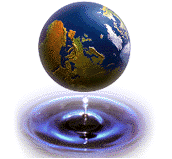In the last decade of the
20th century alone, the earth's population increased by more than one billion
people. At present rates, over the next 50 to 90 years the world's population
will more than double. The demand on water supplies is growing exponentially.
Clearly, understanding and using scarce water resources wisely is vital. Our
very survival as a species depends on it.
Demands on
Water Resources Continue to Increase
 Count the ways you and your
family use water: drinking, cooking, bathing, doing laundry, housecleaning, watering the lawn,
washing the car, giving the dog a bath. In industrialized
countries, the average family of four consumes 250 gallons of water each day.
Count the ways you and your
family use water: drinking, cooking, bathing, doing laundry, housecleaning, watering the lawn,
washing the car, giving the dog a bath. In industrialized
countries, the average family of four consumes 250 gallons of water each day.
But that's only a small part of
the water usage picture. So many of the things that we take for granted, things
that make our lives easier, also depend on water—vast quantities of water
Consider that it took
approximately 100,000 gallons of water to manufacture your family's car. The
newspaper that landed on your doorstep last Sunday morning soaked up 280 gallons
of water just to print. And that five-pound sack of flour sitting on your
kitchen shelf required 375 gallons of water to produce. In the United States,
water consumption increased by more than 100 percent in the last half century.
In the same period, it rose by more than 500 percent in Europe and 300 percent
in Africa. Many experts predict world consumption will double by 2020.
Concerns About
Water Quality
 You're not alone if you're
concerned about the water you and your family drink. A survey by the Water
Quality Association found that three-quarters of Americans don't believe their
household water supply is as safe as it could be. In a recent USA
Today/CNN/Gallup Poll, 47 percent of respondents reported they won't drink water
straight from the tap.
You're not alone if you're
concerned about the water you and your family drink. A survey by the Water
Quality Association found that three-quarters of Americans don't believe their
household water supply is as safe as it could be. In a recent USA
Today/CNN/Gallup Poll, 47 percent of respondents reported they won't drink water
straight from the tap.
Environmental problems have an
enormous impact on water quality. Water runoff from industrial plants and farms,
acid rain and other forms of pollution have tainted groundwater and surface
water supplies in many areas of the world. Population growth, urban and suburban
sprawl, and industrial and agricultural expansion continue to stress fresh water
supplies.
Water contamination problems,
epidemic in the developing world, also routinely occur in highly industrialized
nations. In the last half dozen years, numerous cases have been recorded in the
United States, affecting tens of millions of consumers in more than 1,000
communities.
Some of the most serious
incidents have involved bacteria. A 1993 outbreak of cryptosporidium in
Milwaukee affected more than 400,000 residents and caused more than 100
attributable deaths. Other virulent pathogens have also intruded into municipal
water supplies with alarming frequency.
Some
Answers
Today governments around the
globe, on every level, are investing hundreds of billions of dollars to improve
infrastructure and mandate higher water quality standards. In addition, more and
more individuals are relying on modern home water treatment systems to assure an
ample supply of fresh, pure water for their families at the most local of all
levels—the home.

